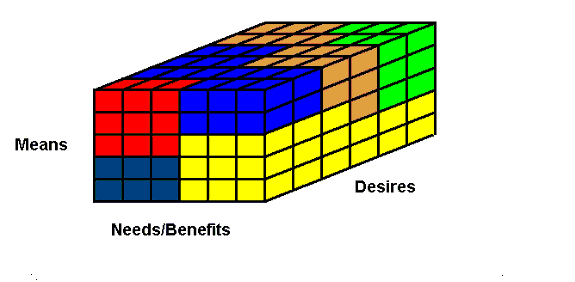| |
| |
|
|
 |
 |
SDR's Approach to Segmentation and Market Structure |
 |
|
Segmentation is unique among the many research applications marketers regularly use. |
|
- There is no such thing as a significance test that tells you when you got it right.
- Truly actionable results are particularly difficult to achieve in segmentation research.
|
|
- More than in any other research application, different business objectives may lead to very different conceptual approaches, interviewing methodologies, analytic techniques, etc. Hence, there is no single best approach to segmentation.
- Consumer segmentations have different dynamics than B-2-B segmentations.
- Multi-cultural (or multi-country) segmentations require different approaches than single-county segmentations.
- Exploratory segmentations use different techniques then predictive segmentations.
- Multidimensional segmentation schemes provide different insights than unidimensional segmentations.
- Products are segmented differently than product users, which are segmented differently than usage occasions.
These are just a few of the complexities of good segmentation research. Segmentation schemes are often deceptively easy to develop - but the results can be stunningly useless if the developer fails to recognize the complexities or simply applies a standard analytical scheme.
At SDR we have 25 years of experience with hundreds of different segmentations. In addition to mastery of the typical segmentation tools, we have developed some of our own techniques and methodologies. We continuously develop unique tools to analyze, report and implement segmentation schemes, and have trained hundreds of other researchers and marketers in the techniques and approaches to market segmentation.
|
| Multidimensional Segmentation |
In segmenting markets, most researchers use a single set of basis variables, such as demographics, psychographics, product category-related attitudes, product usage-related behaviors, derived importances from conjoint exercises, or latent structures. However, there is no reason to limit the basis for segmentation to only one type of variable when many criteria actually determine buyers' response to offerings in the category.
These criteria are multidimensional, encompassing attitudes, needs, values, benefits, means, occasions, and prior experiences, depending on the product or service category and the buyer. A segmentation scheme based on only one set of basis variables may have limited utility to the firm because various users of segmentation schemes have different needs. For example, product-development managers may want the market segmented on perceived values and benefits sought; marketing communications managers may want it divided into groups of buyers with similar needs, desires, or psychographic profiles; and sales managers may prefer segmentation based on sales potential or profitability.
A market segmentation based on multiple dimensions, using separate segmentation schemes for each one, is often more useful and more flexible for planning marketing strategy, developing new products, and executing marketing tactics. Thus, researchers may consider different segmentations on a sample of buyers using different bases concerning product-user identity (i.e., performance needs, means, and desires).
That is why SDR typically uses a three-dimensional segmentation scheme, shown below. The three dimensions can be any basis variables that are pertinent to the objectives of the study.
A single cell in the cube represents the intersection of a means-needs/benefits-wants group, and consumers in that cell will be completely described in terms of: (1) Value based purchase behavior, (2) their technology wants and needs, and (3) their revenue potential, and any other attitude/marketing information gathered in the questionnaire.
|
|
Multidimensional Segmentation Model

|
|
The power of the SDR segmentation scheme is that, by using the decision support tool provided, you can aggregate cells into specific market segments based on the varying needs of different internal functional and departmental users while using a common base of homogeneous cells for all of the segmentation methods within the company. For instance:
- Product/service developers can have their own segmentation scheme based on "needs" criteria for cell aggregation (i.e. segments).
- Product/service marketers may have another segmentation scheme based on a different framework.
- Corporate branding or communication managers or pricing groups can have their own segmentation scheme based on their specific frameworks.
Even though each of these user groups has distinctly different needs, each of their segmentation schemes can be directly related to any other because they all use a common base of homogeneous cells.
|
| Benefits of the SDR Segmentation Approach |
SDR's segmentation approach:
- Provides a unified view of different core markets while respecting the key nuances of each,
- Provides a high level of flexibility for development of various products and services,
- Is relevant and usable by all marketing, sales, product development, and market planning constituencies within the company,
- Is actionable in terms of target marketing and sales efforts at all levels of the organization,
- Increase management usability by offering the opportunity to dynamically define target segments with any one, two, or all three dimensions, depending on management or program service needs, and
- Be tied directly to a consumer/prospect database to enhance targeted direct marketing and relationship building efforts.
|
|
|
|
|
|
|

